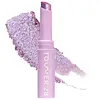Tower 28 Beauty Gogo Cooling Shimmer 8H Eyeshadow Stick Versus Romand Better Than Palette The Secret Garden
What's inside
What's inside
 Key Ingredients
Key Ingredients

 Benefits
Benefits

 Concerns
Concerns

 Ingredients Side-by-side
Ingredients Side-by-side

Water
Skin ConditioningSynthetic Fluorphlogopite
Propanediol
SolventCalcium Sodium Borosilicate
Chondrus Crispus Powder
AbrasivePentylene Glycol
Skin ConditioningSaccharide Isomerate
HumectantHydroxyacetophenone
AntioxidantCalcium Chloride
Astringent1,2-Hexanediol
Skin ConditioningCaprylyl Glycol
EmollientSilica
AbrasiveMica
Cosmetic ColorantCalcium Aluminum Borosilicate
Tetrasodium Glutamate Diacetate
Aminomethyl Propanediol
BufferingAluminum Calcium Sodium Silicate
Tin Oxide
AbrasiveCitric Acid
BufferingSodium Citrate
BufferingIron Oxides
CI 77891
Cosmetic ColorantWater, Synthetic Fluorphlogopite, Propanediol, Calcium Sodium Borosilicate, Chondrus Crispus Powder, Pentylene Glycol, Saccharide Isomerate, Hydroxyacetophenone, Calcium Chloride, 1,2-Hexanediol, Caprylyl Glycol, Silica, Mica, Calcium Aluminum Borosilicate, Tetrasodium Glutamate Diacetate, Aminomethyl Propanediol, Aluminum Calcium Sodium Silicate, Tin Oxide, Citric Acid, Sodium Citrate, Iron Oxides, CI 77891
Polybutylene Terephthalate
Bis-Diglyceryl Polyacyladipate-2
EmollientAcrylates Copolymer
Ethylene/Va Copolymer
Emulsion StabilisingPolyethylene Terephthalate
Polyglyceryl-2 Triisostearate
EmulsifyingMethylpropanediol
SolventPropanediol
SolventCalcium Titanium Borosilicate
AbrasiveCalcium Aluminum Borosilicate
CI 77891
Cosmetic ColorantDiphenylsiloxy Phenyl Trimethicone
Skin ConditioningPolypropylene
Octyldodecanol
EmollientDiisostearyl Malate
EmollientHydrogenated Castor Oil Dimer Dilinoleate
Skin ConditioningPhytosteryl/Isostearyl/Cetyl/Stearyl/Behenyl Dimer Dilinoleate
Skin ConditioningSilica
AbrasiveCalcium Sodium Borosilicate
Mica
Cosmetic ColorantSynthetic Fluorphlogopite
Disteardimonium Hectorite
StabilisingPropylene Carbonate
SolventCI 77491
Cosmetic ColorantCI 75470
Cosmetic ColorantTriethoxycaprylylsilane
Octyldodecyl Stearoyl Stearate
EmollientPhenylpropyldimethylsiloxysilicate
EmollientMagnesium Stearate
Cosmetic ColorantTrimethylsiloxysilicate
EmollientHydrogenated Polydecene
EmollientEthylene/Propylene Copolymer
AbrasiveCI 77510
Cosmetic ColorantCI 15985
Cosmetic ColorantIsododecane
EmollientNylon-12
Phenyl Trimethicone
Skin ConditioningMagnesium Myristate
Polybutene
Dimethicone
EmollientAluminum Distearate
Emulsion StabilisingDimethicone/Vinyl Dimethicone Crosspolymer
Skin ConditioningPhenoxyethanol
PreservativePolyurethane-11
CI 15850
Cosmetic ColorantCI 19140
Cosmetic ColorantCI 77000
Cosmetic ColorantWater
Skin ConditioningPolybutylene Terephthalate, Bis-Diglyceryl Polyacyladipate-2, Acrylates Copolymer, Ethylene/Va Copolymer, Polyethylene Terephthalate, Polyglyceryl-2 Triisostearate, Methylpropanediol, Propanediol, Calcium Titanium Borosilicate, Calcium Aluminum Borosilicate, CI 77891, Diphenylsiloxy Phenyl Trimethicone, Polypropylene, Octyldodecanol, Diisostearyl Malate, Hydrogenated Castor Oil Dimer Dilinoleate, Phytosteryl/Isostearyl/Cetyl/Stearyl/Behenyl Dimer Dilinoleate, Silica, Calcium Sodium Borosilicate, Mica, Synthetic Fluorphlogopite, Disteardimonium Hectorite, Propylene Carbonate, CI 77491, CI 75470, Triethoxycaprylylsilane, Octyldodecyl Stearoyl Stearate, Phenylpropyldimethylsiloxysilicate, Magnesium Stearate, Trimethylsiloxysilicate, Hydrogenated Polydecene, Ethylene/Propylene Copolymer, CI 77510, CI 15985, Isododecane, Nylon-12, Phenyl Trimethicone, Magnesium Myristate, Polybutene, Dimethicone, Aluminum Distearate, Dimethicone/Vinyl Dimethicone Crosspolymer, Phenoxyethanol, Polyurethane-11, CI 15850, CI 19140, CI 77000, Water
 Reviews
Reviews

Ingredients Explained
These ingredients are found in both products.
Ingredients higher up in an ingredient list are typically present in a larger amount.
Calcium Aluminum Borosilicate is made up of calcium, aluminum, and silicates. It is a glass-like material. In cosmetics, it comes in the form of flakes or microspheres.
Calcium aluminum borosilicate is a bulking agent, meaning it helps thicken a product.
This ingredient is created by slowly mixing several minerals, including kaolin clay.
Although “aluminum” in an ingredient name can raise red flags for some consumers, the form and usage context matter significantly. For typical topical applications, there is no substantial evidence of health risks - such as cancer, neurotoxicity, or systemic “aluminum overload.”
Learn more about Calcium Aluminum BorosilicateCalcium Sodium Borosilicate is a bulking agent. It is considered a borosilicate glass; it is composed of powder or flakes of calcium and sodium borosilicates.
This ingredient is used to add volume, shine, and color to products. You'll most likely find this ingredient in makeup products.
According to in-vivo and ex-vivo studies done by a manufacturer, this ingredient works well with UV filters:
Learn more about Calcium Sodium BorosilicateCi 77891 is a white pigment from Titanium dioxide. It is naturally found in minerals such as rutile and ilmenite.
It's main function is to add a white color to cosmetics. It can also be mixed with other colors to create different shades.
Ci 77891 is commonly found in sunscreens due to its ability to block UV rays.
Learn more about CI 77891Mica is a naturally occurring mineral used to add shimmer and color in cosmetics. It can also help improve the texture of a product or give it an opaque, white/silver color.
Serecite is the name for very fine but ragged grains of mica.
This ingredient is often coated with metal oxides like titanium dioxide. Trace amounts of heavy metals may be found in mica, but these metals are not harmful in our personal products.
Mica has been used since prehistoric times throughout the world. Ancient Egyptian, Indian, Greek, Roman, Aztec, and Chinese civilizations have used mica.
Learn more about MicaPropanediol is an all-star ingredient. It softens, hydrates, and smooths the skin.
It’s often used to:
Propanediol is not likely to cause sensitivity and considered safe to use. It is derived from corn or petroleum with a clear color and no scent.
Learn more about PropanediolSilica, also known as silicon dioxide, is a naturally occurring mineral. It is used as a fine, spherical, and porous powder in cosmetics.
Though it has exfoliant properties, the function of silica varies depending on the product.
The unique structure of silica enhances the spreadability and adds smoothness, making it a great texture enhancer.
It is also used as an active carrier, emulsifier, and mattifier due to its ability to absorb excess oil.
In some products, tiny microneedles called spicules are made from silica or hydrolyzed sponge. When you rub them in, they lightly polish away dead skin layers and enhance the penetration of active ingredients.
Learn more about SilicaSynthetic Fluorphlogopite is the synthethic version of mica. It consists of fluorine, aluminum and silicate.
Synthetic Fluorphlogopite is used to add volume to products.
It is considered non-irritating on the skin.
Learn more about Synthetic FluorphlogopiteWater. It's the most common cosmetic ingredient of all. You'll usually see it at the top of ingredient lists, meaning that it makes up the largest part of the product.
So why is it so popular? Water most often acts as a solvent - this means that it helps dissolve other ingredients into the formulation.
You'll also recognize water as that liquid we all need to stay alive. If you see this, drink a glass of water. Stay hydrated!
Learn more about Water